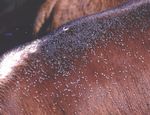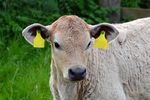Fly Season 2021 It's Costing You!
←
→
Page content transcription
If your browser does not render page correctly, please read the page content below
Fly Season 2021
It’s Costing You!
Flies seem to be in abundance for most cattle producers this year. Although
there are a lot of “home remedies” available for producers, most successful
fly control strategies are well planned, based on research and strategically ap-
plied. A thought to consider, did your fly control program work last year?
If it did not, now is the time to consider a different method.
Typically, there are three fly species that economically impact grazing cattle;
the horn fly, face fly and stable fly.
Horn Flies
Horn flies are small in size, approximately 3/16” in length and are usually Horn Flies
found on the backs, sides and poll area of cattle. During a warm summer
afternoon, they can be found on the belly region of cattle. Horn flies, both male and females flies, acquire
more than 30 blood meals per day. After mating, the female fly will leave the animal to deposit eggs in
fresh cattle manure. Eggs hatch within one week, and larvae feed and mature in the manure, pupating in
the soil beneath the manure pat. Newly emerged horn flies can travel several miles searching for a host.
The entire life cycle can be completed in 10 to 20 days depending upon the weather.
Economic losses associated with horn flies are estimated at more than $1 billion dollars annually in the
United States. Horn fly feeding causes irritation, blood loss, decreased grazing efficacy, reduced weight
gains, and diminished milk production. It is well known that stress from any source reduces efficiency,
increases cost of gain or production, and shortens the productive life of the animal. Additionally, horn flies
have been implicated in the spread of summer mastitis in lactating females due to their congregation on
udders, and introducing bacteria to the teat end.
Studies conducted in the U.S. and Canada have shown that horn flies can cause weight gain loss in cattle,
and calf weaning weights can be negatively impacted from 4 – 15 percent. Other studies have established
calf weaning weights were 10-20 pounds higher when horn flies were controlled on mother cows. The
economic injury level (EIL) for horn flies is about 200 flies per animal. Yearling cattle can also be affected by
the horn fly; other studies have shown yearling weights can be reduced by as much as 18 percent.
There are many insecticide control methods available to manage horn fly numbers; back rubbers, dust
bags, insecticidal ear tags and strips, pour-ons, oral larvicides, low pressure sprayers, and automatic
sprayers.
Milton Orr
204 North Cutler Street, Suite 105
Greeneville, TN 37745
Phone: (423) 798-1710
Email: morr3@utk.eduBack rubbers and dust bags can be an effective way to reduce horn fly
numbers if cattle are forced to use them and they are kept charged. Common
mistakes with these methods include hanging them too high so that cattle
can avoid them by passing under the ends or placing them where use is
optional to the cattle. Placement should include alleyways to water and
mineral, passageways between pastures, or on mineral feeders. Young cattle
are more reluctant to use them and can often avoid them when placement is
made for larger animals.
Calf avoiding the back rubber.
Insecticide ear tags and strips are a convenient method of horn fly control.
However, many horn fly populations can exhibit resistance to insecticides.
The recommended management practice to maintain horn fly control is to
rotate insecticide classes. Keep in mind there are different types of
insecticides in each class of insecticide, to be effective, producers must
change classes of insecticides. Also, do not mix classes, but use only one
class each year and change when resistance is noted. Another rule of thumb
is to remember to remove ear tags at the end of their productive life.
Small trace levels of insecticide from spent fly tags can actually encourage a
population of resistant flies. The useful life of fly tags is often 90 to 120 days, Two tags are recommended.
meaning that if they are applied too early, they will likely be spent before the
real pressure of fly season occurs.
Animal sprays and pour-on products will provide 7-21 days of control and
will need to be re-applied throughout the fly season.
Oral larvicides prevent fly larvae from developing into adults. An important
factor when using an oral larvicide is ensuring steady consumption. An
additional complicating issue using an oral larvicide is horn fly migration from
neighboring untreated herds which can mask the effectiveness of an oral
larvicide.
Automatic Sprayer
Face fly adults closely resemble house flies except they are slightly larger and
darker than the house fly. The face fly is a non-biting fly that feeds on animal
secretions, nectar and dung liquids. The adult female face flies clustering
around an animal’s eyes, mouth and muzzle, can cause extreme annoyance.
Face flies will also feed on blood and other secretions around wounds caused
by mechanical damage or other injury.
Face flies are present throughout the summer but populations usually peak
in late July and August. Face flies are most numerous along waterways, areas
with abundant rainfall, and shaded vegetation. Face Fly
Female face fly feeding causes damage to eye tissues, increases susceptibility to eye pathogens, and vector
Moraxella bovis, the causal agent of pinkeye or infectious bovine keratoconjuctivitis. Pinkeye is a highly
contagious inflammation of the cornea and conjunctiva of cattle. If coupled with the infectious bovine
rhinotrachetis (IBR) virus, M. bovis can cause a much more severe inflammatory condition. Controlling face
flies is essential in reducing most pinkeye problems.Achieving adequate face fly control can be difficult because of their habit of feeding around the face and the significant time they spend off the animal. Control is maximized when the cattle receive daily insecticide applications by either dust bags, oilers, sprays, or an insecticide impregnated ear tag/strip. Ear tags/strips should be applied at the label recommended rate. Both cows and calves must be treated if control is to be achieved. Pinkeye vaccines are available and should be considered if face flies and pinkeye have been a recurring problem. Currently, commercial and autogenous pinkeye vaccines are available; please check with your local veterinarian about the use of these products. Stable Flies Stable flies are serious pests of feedlots and dairies and of pasture cattle. The stable fly is a blood feeder, mainly feeding on the front legs of cattle, staying on the animal long enough to complete a blood meal. Their bites are very painful; cattle will often react by stomping their legs, bunching at pasture corners, or stand in water to avoid being bitten. The female stable fly deposits eggs in spoiled or fermenting organic matter mixed with animal manure, soil and moisture. Stable Fly The most common developing sites are in lots, usually around feed bunks, along the edges of feeding aprons, under fences, and along stacks of hay, alfalfa and straw. Grass clippings and poorly managed compost piles also may be stable fly developing sites. Winter hay feeding sites where hay rings are used can often be a source for larval development through the summer if enough moisture is present. Moving the piles of organic material or mechanical disruption to promote drying of the site can help manage stable fly populations. The life cycle of the stable fly can take 14-24 days, depending on weather conditions. While the source of early season stable flies on pastured cattle it not well understood some might develop from larvae overwintering locally. Science indicates that stable flies can move at least 10 miles or more. Stable flies cause similar weight gain losses to both pasture and confinement cattle. Research has recorded a reduction in average daily gain of 0.44 lbs. per head with animals which received no insecticide treatment compared to animals which received a treatment. Remember, stress can accumulate from multiple sources to escalate to economically devastating proportions. The only adult management option available for the control of stable flies on range cattle is use of animal sprays. Sprays can be applied using a low-pressure sprayer. Timely applications of these products will be required to achieve reduction in fly numbers. Sanitation or clean-up of wasted feed at winter feeding sites may reduce localized fly development. But, sanitation alone may not totally reduce the economic impact of stable fly feeding.
You can also read























































